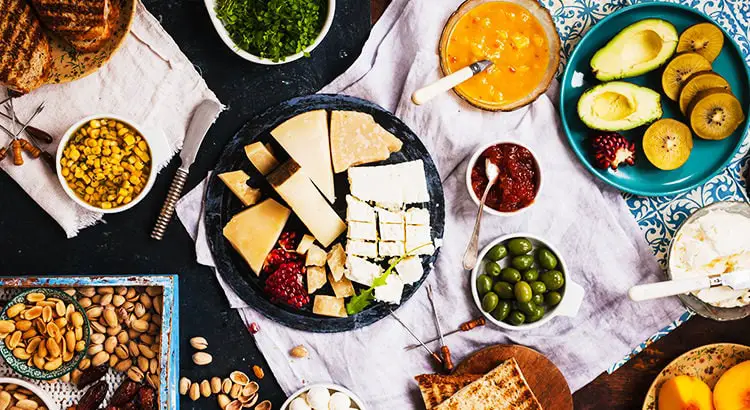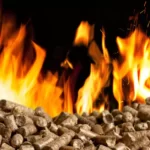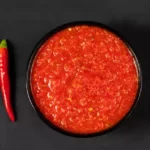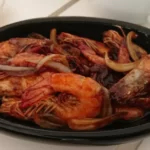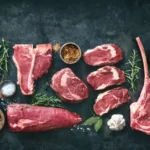Discovering new flavors through smoking isn’t restricted to meat. This cooking method, a cultural and culinary practice that dates back centuries, extends far beyond brisket, ribs, or salmon. A smoky note can enhance the taste profile of a diverse range of foods, offering a unique culinary experience that’s a feast for the senses.
Smoking isn’t just for meat. Fruits, vegetables, dairy products, nuts, seeds, seafood, and even herbs and spices can be smoked to add a rich depth of flavor. This smoke-infused twist on familiar foods introduces an exciting new avenue for taste exploration.
The world of smoked foods is expansive and versatile, providing endless possibilities for enhancing your culinary repertoire. From smoked cheese to smoked nuts, the smoky flavor can transform everyday foods into gourmet delights.
The Art of Smoking Food
History and Evolution of Smoking Foods
Originating from primitive societies, smoking food started out as a preservation technique. People discovered that the antimicrobial and antioxidant properties of smoke prolonged the shelf life of their food, keeping it safe for consumption over extended periods. As societies evolved and food storage technology improved, smoking transitioned from being purely utilitarian to a favored method for flavor enhancement. Appreciation for the unique, savory characteristics that smoking imparts to food has led to its widespread adoption in cuisines worldwide.
Types of Smokers and Their Uses
Over time, numerous styles of smokers have been developed, each offering a distinct cooking experience. Let’s explore some of the most common types:
- Offset Smokers: Traditional and widely used, offset smokers feature a large, cylindrical cooking chamber with a smaller, offset firebox. They’re known for producing a deep, robust smoky flavor but require more skill and attention to maintain the right temperature.
- Vertical or Bullet Smokers: Compact and efficient, these smokers have a vertical design with the heat source directly below the food. They’re excellent for slow, steady smoking, producing evenly cooked and well-flavored food.
- Box or Cabinet Smokers: Shaped like a refrigerator, box smokers have a heat source at the bottom, food racks in the middle, and a chimney on top. They’re loved for their large capacity and ease of use, ideal for smoking large quantities of food at once.
- Kettle Grills: A dual-purpose tool, kettle grills can be used for grilling and smoking. When used as a smoker, they can impart a delicious smoky flavor, although they require more hands-on attention.
- Pellet Smokers: These smokers use wood pellets for fuel and offer a high degree of control over cooking temperature. Ideal for ‘set it and forget it’ cooking, pellet smokers can impart a mild, wood-fired flavor to your food.
Fruits and Vegetables: Unlikely Candidates for Smoking
Popular Fruits and Vegetables for Smoking
Smoking fruits and vegetables might sound unconventional, but the results can be spectacularly flavorful. Here are a few options to consider:
- Fruits: Apples, peaches, pineapples, and pears hold up well to smoking. They absorb the smoke, developing a caramelized, smoky-sweet flavor profile that’s fantastic in desserts or as a unique side dish.
- Vegetables: Hardy vegetables like corn, bell peppers, onions, zucchinis, and eggplants can take on a wonderful smoky flavor. They pair well with grilled meats or can make a tasty, smoke-infused vegetarian meal.
Tips for Smoking Fruits and Vegetables
When it comes to smoking fruits and vegetables, certain strategies can help maximize flavor and texture:
- Temperature Control: Keep your smoker temperature low. Fruits and vegetables are more delicate than meat and can quickly become mushy if cooked at high temperatures.
- Wood Choice: Using a fruit wood, like apple or cherry, can provide a milder smoke that complements rather than overpowers the natural flavors of fruits and vegetables.
- Preparation: Large, uniform cuts are best for smoking to ensure even cooking. For fruits, consider leaving the skins on to help retain shape and moisture.
Smoking Dairy: Cheese and More
Exploring Smoked Cheeses
Smoking can elevate the flavor profile of many types of cheese. The process adds a smoky depth and richness that pairs beautifully with a variety of dishes. Here are a few popular cheeses to smoke:
- Gouda: This semi-hard cheese takes on a nutty, sweet flavor when smoked, which complements its natural creamy, buttery taste.
- Cheddar: A favorite for smoking, cheddar develops a robust, smoky flavor that works wonderfully in a variety of dishes.
- Mozzarella: Smoking gives this mild, creamy cheese a new layer of complexity, making it a fantastic topping for pizzas, salads, and sandwiches.
How to Smoke Cheese at Home
Smoking cheese at home is a rewarding process. Here are some tips to get you started:
- Choose the Right Cheese: Semi-hard to hard cheeses work best for smoking. Softer cheeses can melt under the heat, while hard cheeses hold up well and absorb smoke nicely.
- Maintain Low Temperatures: Cheese has a low melting point, so cold smoking is necessary. Cold smoking imparts a smoky flavor without cooking the food, ideal for heat-sensitive items like cheese.
- Turn Regularly: Rotate the cheese periodically to ensure even exposure to smoke on all sides.
- Rest Before Eating: Allow smoked cheese to rest in the refrigerator for a few days after smoking. This helps the flavors to mellow and blend together.
Other Dairy Products You Can Smoke
Cheese isn’t the only dairy product that benefits from a kiss of smoke. Here are a few other candidates:
- Butter: Smoked butter has a rich, complex flavor that’s delicious on bread, steak, or cooked vegetables.
- Yogurt: Smoke-infused yogurt can add a surprising twist to dips, marinades, and sauces.
- Cream: Smoked cream can be used to make a savory whipped cream or an unusual, smoky ice cream.
Smoked Nuts and Seeds
Suitable Nuts for Smoking
Nuts have a natural richness and high-fat content that pairs wonderfully with the depth of smoked flavor. Try smoking these varieties:
- Almonds: Smoke adds an extra layer of flavor to almonds, perfect for snacking or adding to salads and cheese boards.
- Pecans: When smoked, pecans take on a robust flavor that’s fantastic in sweet and savory dishes.
- Walnuts: Smoking walnuts can temper their natural bitterness, resulting in a mellow, smoky nut that’s great in baking or salads.
Steps for Smoking Nuts and Seeds
Follow these steps for flavorful smoked nuts:
- Soak the Nuts: Before smoking, soak the nuts in water for a few minutes. This helps them absorb more smoke.
- Spread Them Out: Spread the nuts in a single layer in a perforated pan or on a grill mat.
- Smoke and Rest: Smoke for 1-2 hours at a low temperature, then let the nuts rest for a few hours to allow the smoke flavor to penetrate deeply.
Smoked Drinks: Unexpected yet Delicious
Popular Drinks to Smoke
Smoking isn’t just for solids. You can bring a smoky, complex flavor to a variety of beverages:
- Cocktails: Drinks like the Smoky Martini or Mezcal Negroni owe their unique character to smoke. You can also experiment with classics like the Old Fashioned or Margarita by adding a smoke component.
- Non-Alcoholic Drinks: Lemonade or iced tea can be transformed with a hint of smoke, creating a refreshing, multi-dimensional drink. Even coffee or hot chocolate can be smoked for a comforting, complex treat.
How to Smoke Drinks at Home
Smoking drinks at home can be a fun way to experiment with flavors. Here’s a simple method:
- Choose Your Smoke Source: You can use a smoking gun, handheld smoker, or even a small grill. For a handheld smoker, simply place the drink in a glass, cover it with plastic wrap, then insert the tube of the smoker, filling the glass with smoke.
- Smoke the Drink: Let the smoke infuse in the drink for a few minutes before removing the plastic wrap. Stir or shake the drink to evenly distribute the smoke flavor.
- Serve: Serve the drink immediately to enjoy the full effect of the smoke. Garnish as desired.
Cooking Techniques for Smoking Foods Other Than Meat
Cold Smoking
Cold smoking imparts a smoky flavor without cooking the food. The smoke is generated in a chamber separate from the food, ensuring the temperature doesn’t rise above 90°F. This method is ideal for foods like cheese, butter, and certain types of fish like salmon.
Hot Smoking
Hot smoking both cooks and smokes the food, with temperatures ranging from 165°F to 300°F. It’s an excellent method for foods that need to be fully cooked, like vegetables, nuts, and certain types of fish.
Smoke Roasting
Also known as pit roasting, this method involves higher temperatures (250°F to 350°F) and shorter cooking times. It’s excellent for foods that benefit from a crisp exterior, such as vegetables and nuts.
Using Different Woods for Flavor
The choice of wood can significantly impact the flavor of smoked food. Here’s a quick guide:
- Mild Woods (Fruit Woods): Woods like apple, cherry, or peach are milder and sweeter, excellent for fruits, vegetables, cheese, and nuts.
- Medium Woods: Woods like oak and hickory impart a balanced, medium-strength smoky flavor, suitable for most foods.
- Strong Woods: Mesquite is a robust, strong-flavored wood, best used sparingly with foods that can stand up to its intense flavor.
Frequently Asked Questions
What Can I Smoke Besides Meat?
Apart from meat, you can smoke a variety of foods like fruits, vegetables, cheese, nuts, seeds, and even beverages. The smoking process can impart a unique, savory complexity to these foods, enhancing their natural flavors.
What is the Best Type of Smoker for Beginners?
Vertical or bullet smokers are often recommended for beginners due to their compact size, efficiency, and ease of use. They’re excellent for slow, steady smoking, producing evenly cooked and well-flavored food.
Can You Smoke Food in a Normal BBQ Grill?
Yes, a regular BBQ grill can be modified to act as a smoker. Using the indirect grilling method, where the food is placed away from the heat source and the lid is closed to trap the smoke, you can achieve a similar effect to a dedicated smoker.
Conclusion
Smoking isn’t reserved for meats alone. From fruits and vegetables to cheese, nuts, and even drinks, a wide array of foods can benefit from the smoky, rich complexity this cooking method offers. By understanding the basic techniques and principles of smoking, you can experiment with a range of foods and flavors.
The type of smoker you use, the choice of wood for smoke, and the smoking method can all impact the final flavor profile of your food. By choosing these elements thoughtfully, you can unlock new depths of flavor and create truly unique culinary experiences.
As the art of smoking continues to evolve, the boundaries of what foods can be smoked are continually expanding. Whether you’re a seasoned pitmaster or a beginner, venturing beyond traditional smoked meats can open up a world of exciting and delicious possibilities.

